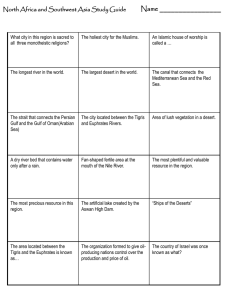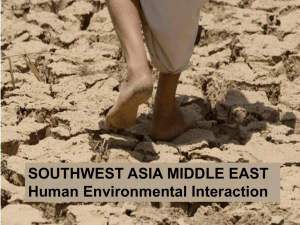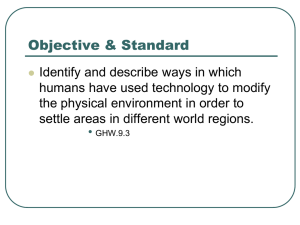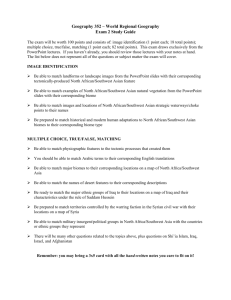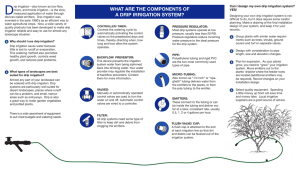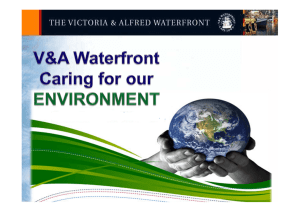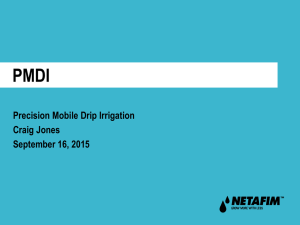SS7G6 and SS7G7 revamp
advertisement
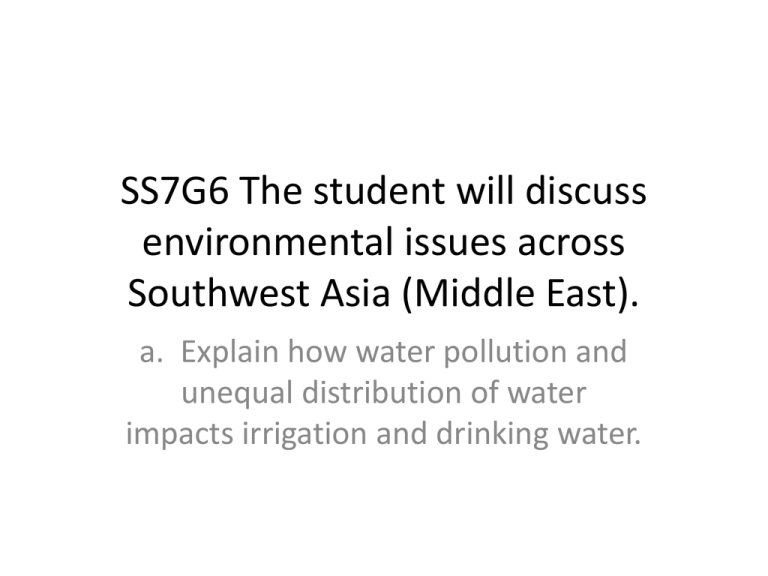
SS7G6 The student will discuss environmental issues across Southwest Asia (Middle East). a. Explain how water pollution and unequal distribution of water impacts irrigation and drinking water. Vocabulary • • • • Irrigation – the use of water for crops Aquifers – Underground lakes Fossil Water – ancient wells Drip Irrigation – using exactly that amount of water each plant needs • Desalination – removing salt from sea water to make it safe for drinking • Hydroelectric power – damming up a river and using the current to create electricity The Fertile Crescent • Much of region is dry and desert or semi-desert. • Euphrates River – longest river in the region – Begins in Turkey, and flows through Syria and Iraq – Joins into one waterway in Iraq – Then flows into the Persian Gulf The Fertile Crescent • Tigris River - begins in the mountains of Turkey and flows south through Iraq. –Both the Euphrates and Tigris provide drinking water and farming –The countries that share these rivers have problems over sharing it Fertile Crescent Fig. 11-1, p. 227 How does the M.E. get water? • Many types of irrigation can be found in Southwest Asia • Farmers bring water to fields from local rivers and underground aquifers (underwater water supplies) • Some farmers tap underwater supplies of fossil water (ancient well water) • Drip Irrigation – used by Israel it drops only the exact amount of water on each plant. • Desalination is also used but it is very expensive and requires lots of energy Pollution • Water pollution is a growing problem in the region • Over production has forced farmers to use dangerous fertilizers that goes into the water supply • Constant planting and fertilizers build up salt level in the soil • Cities grow but they have not figured out to have their own waste management grow with it Water Wars! • Access to water is also a conflict because the many uses for the water • Dams have been built to create reservoirs (man made lakes) and for creating hydroelectric power • Once a dam is built it limits the water down the river Exit Tickets (Fill in the Blank) • 1. What countries are along the Euphrates River? • 2. What is the advantage of using Drip Irrigation? • 3. What causes water pollution in the M.E.? • 4. What is desalinization? SS7G7 The students will explain the impact of location, climate, physical characteristics, distribution of natural resources, and population in Southwest Asia (Middle East) a. Explain how the distribution of oil has affected the development of Southwest Asia (Middle East). Making Money! • Two of the biggest natural resources in the Middle East are; – 1. Natural Gas – 2. Oil • Discovered in the early 1900s • Over half of the worlds Oil supply has been found in this region • Made some Middle Eastern countries very rich OPEC • Southwest Asian countries team up to create in the 1960s OPEC – Organization of Petroleum Exporting Countries • Control over the supply and price of oil • Used embargos as tool (slow down or halt the sale of oil) • While some countries are rich others are very poor • Although Iran has oil and natural gas resources, they had made an attempt to develop nuclear power Less Oil More Problems A major environmental issue facing the countries of the Middle East is the pollution of the Persian Gulf due to oil spills Wars over water and oil are a problem for many Middle Eastern countries Iraq invaded Kuwait primarily to gain control over oil resource Oil, a non-renewable natural resource has help the growth of the Middle East Saudi Arabia has the world’s largest oil deposit in the Middle East Percentage of Oil Around the World The Haves/Have Not's • Largest reserves of natural gas are found in Saudi Arabia, Iraq, Iran and Kuwait • Countries with low reserves of gas or oil have had a difficult time. Exit Tickets (2nd Fill in the Blank) 1. What are the two biggest natural resources in the Middle East? 2. What does OPEC stand for? 3. Where is over half of the world’s oil supplies found? 4. Looking at the map where are your petroleum located? 5. Name two Middle Eastern countries with high reserves of natural gas.

